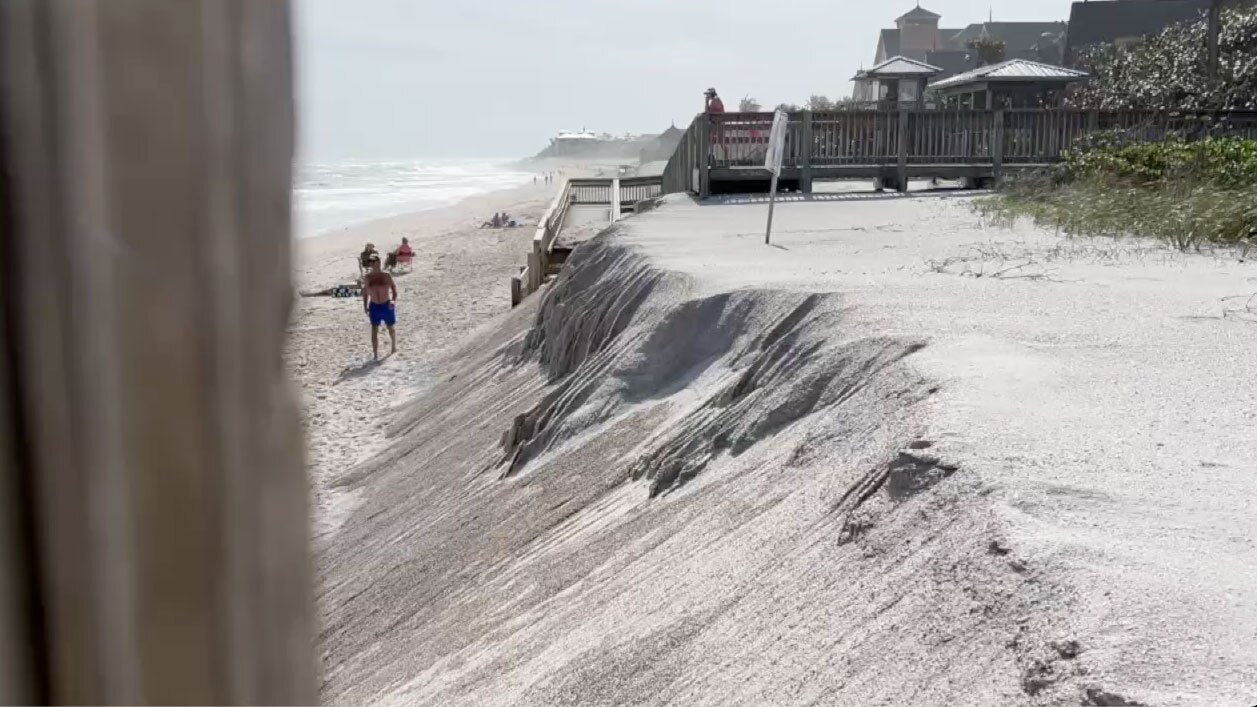INDIAN RIVER COUNTY, Fla. — It's an issue that affects our coastal counties from Palm Beach through the Treasure Coast: Mother Nature eroding the beaches our communities rely so heavily on. A series of storms particularly took its toll last year on beaches.
Indian River County Officials launched their dune restoration project in November, restoring 6.6 miles of county shoreline ravished by past storms, including Hurricanes Ian and Nicole.
Hurricane Ian caused waves over 11 feet, and waves from Hurricane Nicole reached about 19 feet.
"We did not expect to have back-to-back storms in 2022 — Hurricane Nicole especially," Eric Charest, the interim director of Indian River County's Natural Resources Department, said.
Their "Sector 3" dune project was designed to restore sand losses to the dune from these storms by placing beach-compatible sand and native salt-tolerant dune plants.

Yet the project was set back again by Mother Nature when multiple severe weather storms slammed the county in November and December.
"We did see fairly minor to moderate erosion in those December storms, and those December storms did impact our current construction process," Charest said.
Construction has since resumed, and the county's natural resources department gave WPTV a closer look at the project Wednesday.
"Beaches are important," coastal resource manager Quintin Bergman said. "Not only is it a driver for local economies, but it's a habitat for local wildlife like the critically endangered sea turtles."
The project involves placing 274,368 cubic yards, or about 415,000 tons of beach-quality sand and installing approximately 728,633 native salt-tolerant dune plants.
It encompasses the coastline from the Seaview subdivision through about half a mile south of the Turtle Trail Beach access.

WPTV saw crews Wednesday pouring sand from a mine source in Fort Pierce into the Golden Sands Park, which is currently closed to the public.
"This plan was started back in the 1980s, and we've been updating every five to 10 years since," Bergman said. "We're looking at the newest data, new technologies."
Bergman said the current strategy that Indian River County is implementing involves restoring the sand as opposed to constructing a seawall, such as the one being built at Bathtub Beach.
Bergman said dune restoration is more feasible and more sea turtle friendly.
"The county is managing 22 plus miles of beach," Bergman said. "We're going to bring in sand from another location and place it into the natural environment.
Bergman said the sand put into the dunes is regulated by the Florida Department of Environmental Protection and the county to adequately match the beaches.
The sand is judged on average grain, its fine material, amount of shells and color.

Right now, the $13 million project isn't raising property taxes. It's funded by FEMA, the state and the county's tourist tax revenue.
However, Charest said that funding is limited, so WPTV asked what happens if Mother Nature keeps chipping away and funding runs out.
"Could it dip into ad valorem taxes?" asked WPTV's Kate Hussey.
"Is that something that could happen in the future? Anything's possible," Charest said. "That would be something staff would have to bring before to county commissioners."
For now, though, that's not the case and it may never be.
Several beachgoers that WPTV talked to, however, said they've seen the erosion seemingly getting worse after every storm.
"It seems like it's been rougher," beachgoer John Nallin said.
"It's something else, isn't it?" Debbie Carter said about the crashing waves. "The waves keep taking [the sand] away. To me it's devastation, it's a shame."
"They get wiped out all the time," Lisa DeAngelis added. "You can see there's no sand up there. That's the draw to come here, to live here, to be near the water."
Once contractors are done restoring Golden Sands, they'll move south to Wabasso Beach before restoring Turtle Trail and Seagrape Trail.
To avoid impacts on nesting sea turtles, county officials said they will wrap up the projects before April 30.




